Are you thinking about a career in industrial welding or welding engineering technology? Whether you want to enter the welding industry as a capable technician or are simply looking to update your skill set, a welding engineering technology program will help you meet these professional goals.
Welding requires a specific set of skills, knowledge, experience, and talent. Though there are many welding processes, Flux-Cored Arc Welding (FCAW) is a particularly popular method used throughout the field. Listed below, you’ll find everything you need to know about the flux-cored arc welding process.
Table of Contents
First introduced in the 1950’s as an alternative to manual metal arc welding or stick welding, flux-cored arc welding has since become the preferred welding mechanism for various applications across industry segments.
How Flux-Cored Arc Welding Works
FCAW processes involve using a continuous wire-fed electrode, a constant-voltage welding power supply, and the same equipment used in metal active gas welding (MAG welding). Flux-cored arc welding occurs with or without shielding gas and is way more productive and economical than MAG welding.
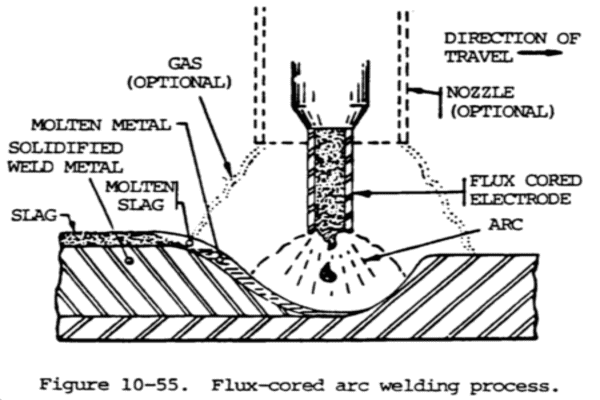
FCAW utilizes the heat created by an electric arc to fuse the base metal in the weld joint region. It uses a hollow or tubular electrode filled with a flux compound (also called a flux-cored wire) that protects the weld pool by forming a gas.
Thanks to the penetrative properties of the flux-cored wires and high deposition rates, the FCAW process finds its use extensively in outdoor welding or welding on contaminated materials. Flux-cored arc welding does not need external shielding gas to safeguard the weld from atmospheric elements.
The use of FCAW for thick materials results in “slag.” You can whittle it out later to give it a clean and polished appearance.
Flux-Cored Arc Welding (FCAW) Uses and Methods
The flux-cored arc welding process takes place in two ways. It is primarily divided into two types based on the shielding method:
Method 1: FCAW by using an external shielding gas
The “dual shield welding” method involves using carbon dioxide with flux to provide additional shielding. The most common shielding gases include carbon dioxide and blends of argon (75%) and carbon dioxide (25%).
The shielding carbon dioxide gas, provided externally using a high-pressure gas cylinder, safeguards the weld pool from oxidation. The metal is also protected by the slag formed as a result of flux melting.
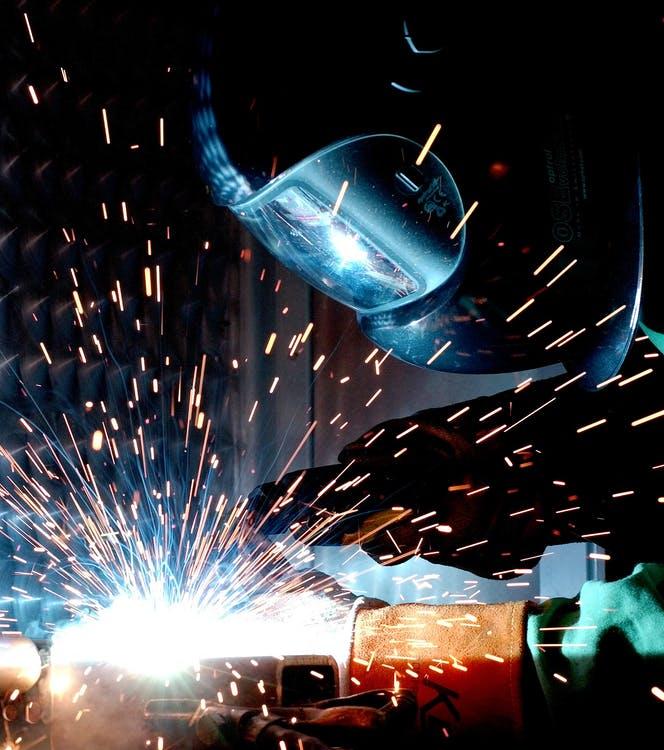
This process is generally applied when thicker metals or materials require welding together. The continuously-fed cylindrical electrode enables high deposition rates and amplified production (compared to solid wire or stick electrode).
Perhaps the only drawback of this process is that strong winds may disturb the carbon dioxide gas shielding and affect welding quality in harsh outdoor conditions.
Method 2: FCAW by relying on the flux core to protect the weld area
This method relies on the gaseous protection and slag formed by the flux-cored electrode to cover and safeguard the molten material or metal in the weld. The filler wire core consists of agents that create shielding gases when the welding arc heat burns them.
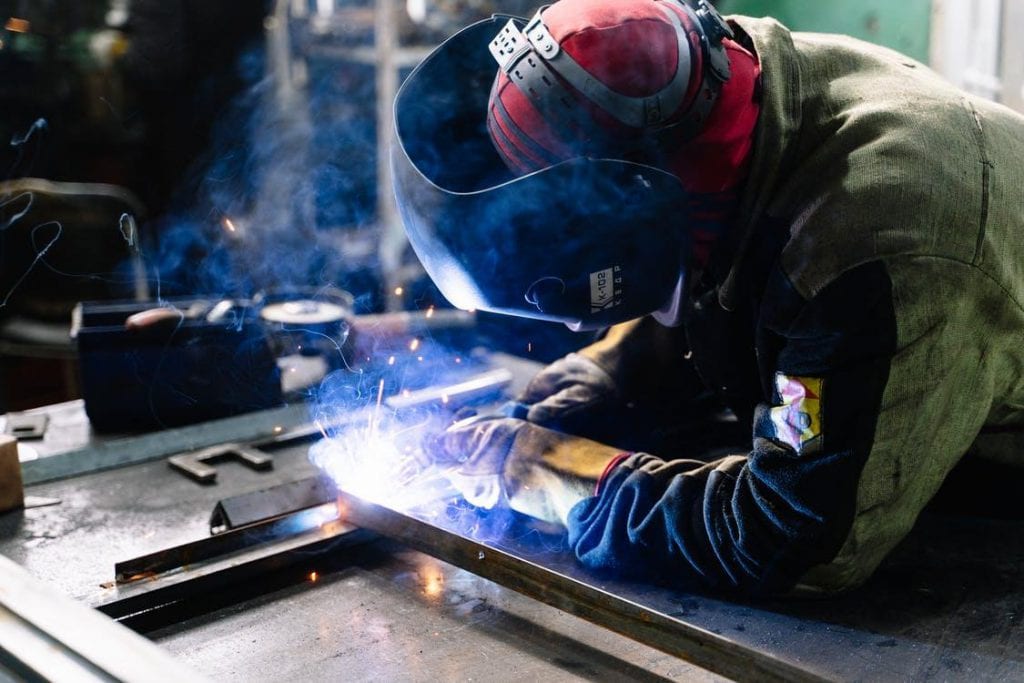
This type of welding is extensively used in heavy outdoor projects, irrespective of weather conditions. The biggest advantage here is that you don’t need external shielding gas as windy conditions don’t disrupt the welding procedure, making it ideal for external (outdoor) applications.
Equipment Needed for FCA Welds
The basic equipment you will need for flux-cored arc welding includes:
- Source of power: The power source or welding machine provides the voltage and amperage supply that helps maintain the welding arc.
- Welding gun: This type of welding utilized both air-cooled and water-cooled guns. Air-cooled guns are easier to maneuver, but water-cooled guns offer a higher degree of efficiency.
- Welding cables: Connector cables (generally made of copper) help connect the welding gun to your power source.
- Wire feeder: The wire feeding motor drives the electrode through the cable and welding gun and has an electrical rotor connected to a gearbox containing drive rolls.
- Shielding gas equipment: While flux-cored arc welding can occur without shielding gas, you might need a gas supply hose, regulator, control valves, and supply hose for some applications.
Flux-Cored Arc Welding Electrodes
Electrodes are what differentiate flux-cored arc welding from MIG welding. While the latter uses solid wires as the filler material or filler metal, the former involves using electrode wires with a hollow flux-filled center. The electrode wires fill with flux, shielding the weld joint from corroding or contaminating due to natural elements.
Which Metals Can Be Welded with FCAW?
FCAW is among the most popular welding processes because of its flexibility and versatility. Metals like cast iron, stainless steel, carbon steel, high-nickel alloys, and low-alloy steels can be easily welded using the flexible FCAW process.
What Are the Advantages and Disadvantages of FCAW?
Advantages
The flux-cored arc welding process finds its use in industries like construction, heavy equipment repair, structural steel erection, shipbuilding, etc. The primary reason for this is that, unlike most other welding processes, FCAW works on all kinds of materials even if contaminated (except for dealing with contaminants like oils, water, and paint).
It can dissolve mill scale and rust, too.
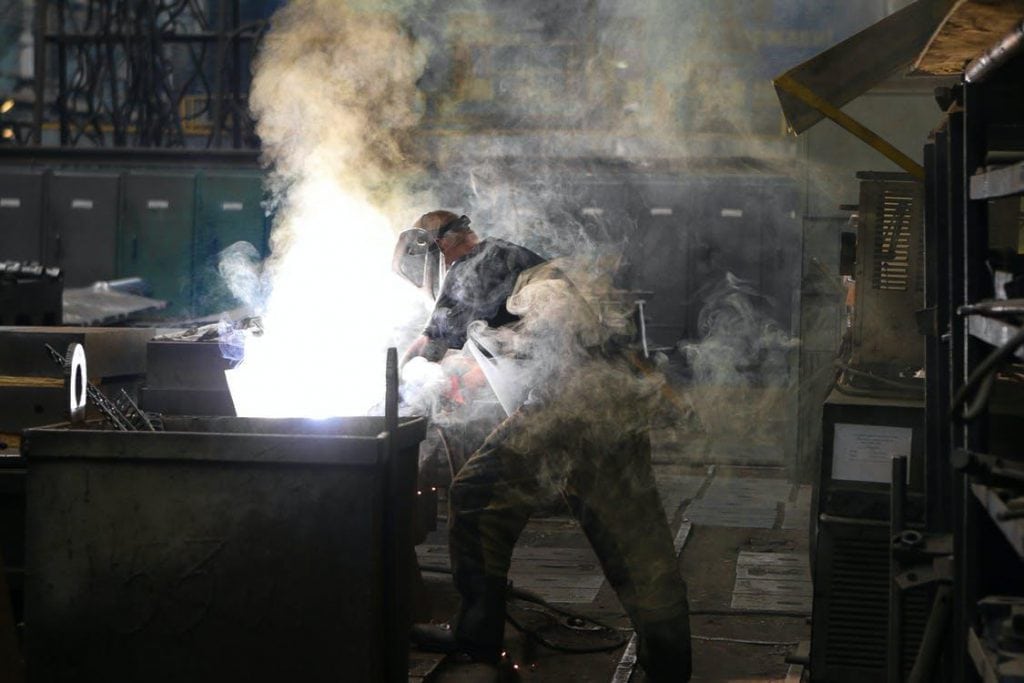
Here’s a look at some of the most significant pros of flux-cored arc welding and the factors that make it essential today’s world:
- This welding method has higher deposition rates (per hour) compared to other techniques.
- The flux core welding process is excellent for welding dirty, rusted, or contaminated metals.
- This welding process is ideal for all welding positions and outdoor welding activities because of the flux shield.
- The flux-cored arc welding process is quite easy to learn and master.
- This welding method does not require a high level of manual dexterity (as in TIG welding).
- FCAW needs very little (extra) equipment, making the welding method convenient.
- FCAW results in better mechanical consistency, strong weld joints, and fewer weld defects.
- Ideal for metals like stainless steel, carbon steel, high-nickel alloys, and low-alloy steels.
Disadvantages
While the FCAW process offers high deposition, protection against the wind and other atmospheric elements, and a host of other benefits, there are a few limitations or restrictions that you should know.
- Since the FCAW [process is not fully automated, there can be a lack of precision due to manual or mechanical errors
- Working near toxic fumes or smoke can be hazardous, and hence, this type of welding must occur in an area that is well ventilated.
- The cost of an FCAW wire (electrode wire) is more than a solid electrode wire.
- The removal of slag is essential to achieve a smooth, finished weld surface.
- The FCAW welding method involves the usage of expensive equipment (compared to other welding processes).
Common Issues and Troubleshooting
Factors like the electrode angles, wire feed speed, arc voltage, electrode extension, and travel speeds can prove the difference between a perfect weld finish and a defective one. Here are some of the most common problems you are likely to face when working on a flux core weld and how to deal with them or prevent them:
- Common wire feeding problems like bird nesting or burn back can cause tangling or extinguish the arc during the welding process. It is best to ensure an appropriate wire feed speed (rate) and distance less than 1.25 inches between the workpiece and contact tip.
- The wrong drive roll tension can also cause the wire to tangle or flatten. You can use U- or V-shaped grooves in the wire feeder and then set the right tension.
- Slag inclusions can prevent the weld’s full penetration due to an incorrect travel speed, heat input, or travel angle. Always clean your weld work between passes and maintain appropriate heat input and travel techniques.
- When the gas from the heated-up flux-cored wire electrode gets stuck in the metal, it can lead to porosity. Ensure you avoid excessive voltage and remove any dirt, dust, paint, oil, rust, or moisture accumulated on the base metal.
Differences Between FCAW, GMAW, and SMAW
FCAW vs. GMAW
Metal Inert Gas (MIG) welding, GMAW, or Gas Metal Arc Welding involves using a continuous solid wire electrode along with shielding gas.
Gas metal arc welding is a common welding process used for vehicle manufacturing, industrial production, construction, and aerospace. Since this type of welding uses gas externally, the wind can hamper the process. GMAW finds its use as a semi- or fully-automatic welding technique.
While FCAW is quite similar to GMAW, the biggest difference is that it doesn’t require you to have an external shielding gas. It revolves around a continuous wire feed process. There are two separate processes associated with flux-cored arc welding, one of which involves using shielding gas.
The other one relies on self-shielding agents (produced when fluxing agents decompose within the welding wire).
FCAW vs. SMAW
Shielded Metal Arc Welding SMAW, also referred to as “stick welding,” is a welding technique used on all ferrous materials. The electrode coating helps de-oxidize the weld area. This generates a shielding gas that protects the weld area from atmospheric contamination.
SMAW finds its use both indoors and outdoors for welding low-alloy and high-alloy steels, nickel alloys, carbon steel, and cast iron (like FCAW). Just like flux-cored arc welding, SMAW, too, creates a layer that you can chip off later.
Flux-cored arc welding is a semi-automatic or manual welding technique that is rarely used indoors. It is generally used outdoors or on contaminated materials. In this case, an electric arc fuses the base material with a continuous filler metal electrode. The shield gas offered by the flux helps protect the weld pool from atmospheric elements.
10 Tips to Improve the Quality of Your FCAW
Here are some pro tips to ensure that your weld joint is of the highest quality and free of complications –
- Use an anti-spatter spray on your part to avoid molten metal from making a mess.
- Avoid burn-back by ensuring the appropriate wire feed speed and MIG gun-to-workpiece distance.
- Always use knurled V- or U-groove drive rolls in your wire feeder to prevent your wire from tangling.
- Make sure there is sufficient space in the weld joint for multiple weld passes.
- Maintain a steady travel speed to avoid undesirable slag inclusions.
- Use a chipping hammer or wire brush to get rid of slag before moving to your next weld pass.
- Maintain appropriate heat input, voltages, and filler wire feed speed to avoid excessive or less-than-ideal penetration.
- Prevent porosity in welding by cleaning any grease, rust, coating, oil, dirt, paint, or moisture from the base metal before you begin.
- It is best to use a filler metal with added de-oxidizers to prevent contaminated welds.
- Maintain a proper electrode stick-out or extension after the step mentioned above.
Learn FCAW with NEIT’s Welding Program
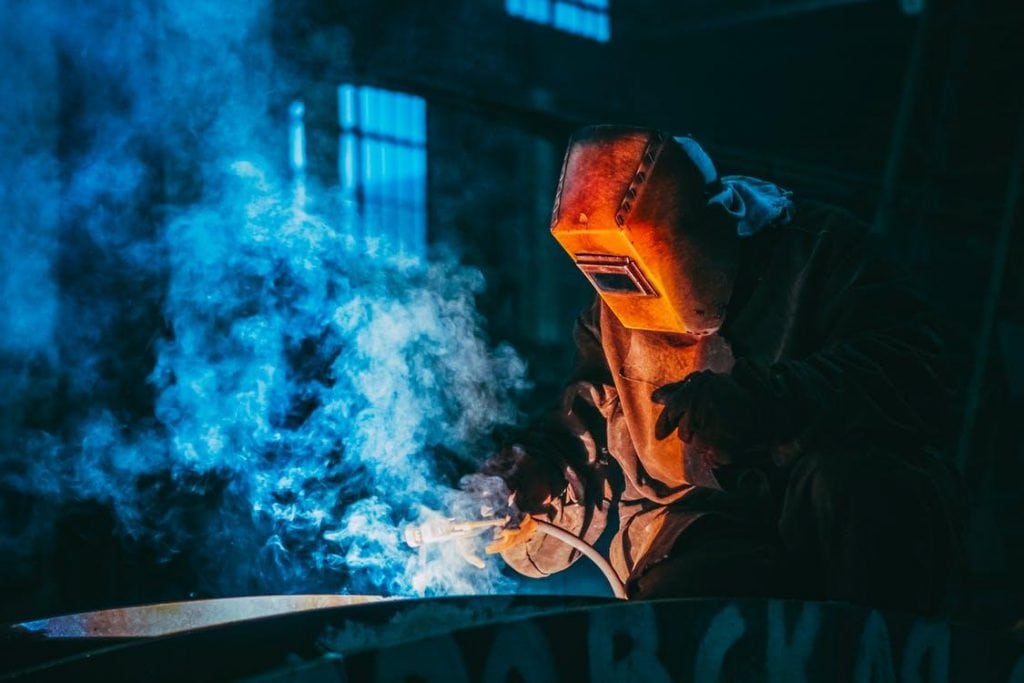
If you’re interested in analyzing, designing, fabricating, and testing welded metal structures or products, this program is for you!
START YOUR WELDING CAREER
Earn your degree in Welding Engineering Technology from NEIT and begin your new career path today!
ASSOCIATE'S DEGREE
BACHELOR'S DEGREE
In addition to popular welding processes such as flux-cored arc welding (FCAW), GMAW, SMAW, GTAW, oxy-acetylene and air-carbon arc cutting, and pipefitting, you also learn about the application of important peripheral subjects like:
- Industrial OSHA safety procedures and policy
- Metallurgy
- Structural design
- CADD
- Destructive and non-destructive testing
- Engineering blueprint reading and interpretation
- Precision measurement
- Materials and manufacturing processes
- Robotic Control Systems
- Workplace Communications
- Basic College Math with Lab
- Technical Math
- Physics and Lab
Upon graduation, you will be eligible to kick-start your career in the welding industry as an entry-level welding technician with a solid foundation in design, welding, and fabrication. NEIT’s associate degree program helps students do the following upon successful graduation:
- Apply your knowledge to the analysis, design, fabrication, and testing of welded metal structures and products.
- Quickly adapt to the emerging applications of mathematics, science, engineering, and technology.
- Think out of the box and apply creativity to the design of welded metal structures and products.
- Identify, analyze, and troubleshoot complex technical problems in any welding process.
- Work with dedication and complete commitment to quality, timeliness, and continuous improvement.
- Leverage the computer as a design, problem-solving, and professional communications tool.
There is no shortage of opportunities for qualified and highly-skilled welding technology graduates. As you gain more experience in the industry and hone your skills, you will be able to pursue any of the following roles in welding technology or related fields:
- Welding engineering technician
- Production welder
- Aluminum welder
- Fabrication welder
- Fitter
- Maintenance welder
- Sub arc operator
- Welding industry salesman
- Industrial engineering technician
- Quality control engineering technician
- CADD designer/technician
- Materials testing technician
- Ship Fitter
- Structural Steel Fitter
This comprehensive program is a great choice for adult learners’ needs, those looking to make a career switch, or even industry professionals looking for a skill upgrade in welding technology.
Learn how NEIT can help you achieve the required skills and abilities to make it big in the welding industry.
Request more information about our program here. You can also give us a call to speak to our team today!
START YOUR WELDING CAREER
Earn your degree in Welding Engineering Technology from NEIT and begin your new career path today!
ASSOCIATE'S DEGREE
BACHELOR'S DEGREE
FAQs
What are the 4 types of welding?
While there are various types and methods used in welding (broadly speaking), here are the four most common ones:
- Gas Metal Arc Welding (GMAW) or Metal Inert Gas (MIG) Welding
- Flux-Cored Arc Welding (self-shielded FCAW)
- Gas Tungsten Arc Welding (GTAW) or Tungsten Inert Gas (TIG) Welding
- Shielded Metal Arc Welding (SMAW)
Read this article to learn more about each of these processes and their application.
What is FCAW welding used for?
Flux-cored arc welding (FCAW) is primarily used for welding thick materials and metals. These include cast iron, carbon steel, stainless steel, high-nickel alloys, and low-alloy steels for activities such as shipbuilding, bridge construction, structural steel erection, and heavy equipment repair across a wide range of heavy industries, including construction.
The continuously-fed tubular electrode helps increase deposition rates and improve productivity. Flux-cored arc welding is generally used for welding contaminated or dirty materials, thanks to its self-protecting properties.

